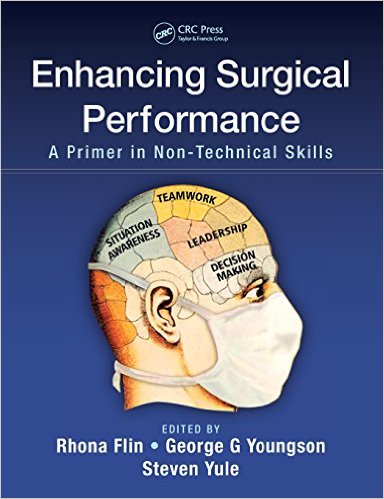A Review by Mark Davenport
(eds) Rhona Flin, George C Youngson, Steven Yule
CRC Press
2014 (priced at £26.72 on Amazon)
 My guess is that you will recognise the name of George Youngson CBE among the authors listed but probably no others. This is something he has been associated with for as long as I have known him and it fits him like a pair of old brogues. He has an avuncular style, warm and welcoming but you can still see the evangelical glint in his eye as he dares you to discuss or dispute the thesis on offer.
My guess is that you will recognise the name of George Youngson CBE among the authors listed but probably no others. This is something he has been associated with for as long as I have known him and it fits him like a pair of old brogues. He has an avuncular style, warm and welcoming but you can still see the evangelical glint in his eye as he dares you to discuss or dispute the thesis on offer.
Surgeons, as you all know, are from a different superhuman species; all-knowing, all powerful and always correct. Unfortunately we can’t do operations in isolation so we have to work with idiots; usually members of the anaesthetic community, nursing staff, theatre ancillary staff and maybe even porters or ward receptionists.
The book doesn’t tell you how to do operations but does attempt to surround each and every one with a mental miasma designed to protect the poor schmuck on the operating table from you, well as an inversion of the vitamin supplement advert goes “you, but on a really bad day”!
This book is broken into chapters on elements including Surgical Performance, Human Factors, Situation Awareness, Decision Making etc. written by a number of contributors, some from surgical backgrounds and others from academic psychology and education. There is an array of acronyms to guide the reader but chief among them is NOTSS (NOn-Technical Skills for Surgeons), NOTECHS (Apparently just “NOn-TECHnical Skills), SMS (Safety Management Systems) and I’M SAFE (Illness, Medication , Stress, Abuse, Fatigue and Emotion – factors which may influence our individual performance).
Essentially as I understand it, the surgical model (NOTSS) followed the airline pilots’ model (NOTECHS) which followed analysis of a series of airline disasters where misinterpretation and miscommunication; faulty interrelationships within the crew led to inappropriate behavioural responses to external threats and problems. The system is now a mandatory part of civil airline practice and every pilot’s education and the clear aim of this book is to transpose it into the surgical community.
There has been widespread introduction of timeouts, surgical pauses, mandatary WHO surgical checklists both before and after the operation to try and reduce wrong-side surgery, wrong-patient surgery and other “never” events and to allow all the components of the team to focus on the task in hand. These still are only tick box exercises after all; not necessarily conducive to efficient surgical throughput. But the key is how to inculcate this “doctrine” among the coming generations? This text needs to be on surgical curricula reading lists every bit as much as standard surgical texts (e.g. Oxford Specialist Handbook (Paediatric Surgery) (eds) Davenport & Pierro 1st edition – amazing value at £31.30+p&p Amazon). NOTSS is now part of the UK –based Intercollegiate Surgical Curriculum Project
and there is an e-learning module (“NOTSS in a box”) available. The concept has also spread beyond the Anglosphere into Japan, Italy, France and Germany among others. There are full team simulations in the USA; but these must be rather expensive and elitist to put together and any appraisals or assessments must suffer as our continuing inability to appraise or assess how juniors actually do operations by themselves.
I do have some criticisms on the format and the obvious one is repetition (11 chapters). Less and less of the concepts stick the further into the book one roams. More and more the examples simply appear as clinical decision-making i.e. the usual things surgeons are supposed to know. For example, whether one resects dead bowel in a midgut volvulus (p83). I would have appreciated a bit more of an “evidence-based” slant on the real value of NOTSS as contributing to the diminution of adverse events. I don’t really want to have to look it up in the literature when it really should be on show here. There must be facts and figures out there, we do collect them.
Lastly, it is worth reading the foreword for a simple answer to the question why. Written by a pilot, he recounts the application of non-technical skills for his profession while in its absence watching it fail for his wife while under the care of ours.
Mark Davenport